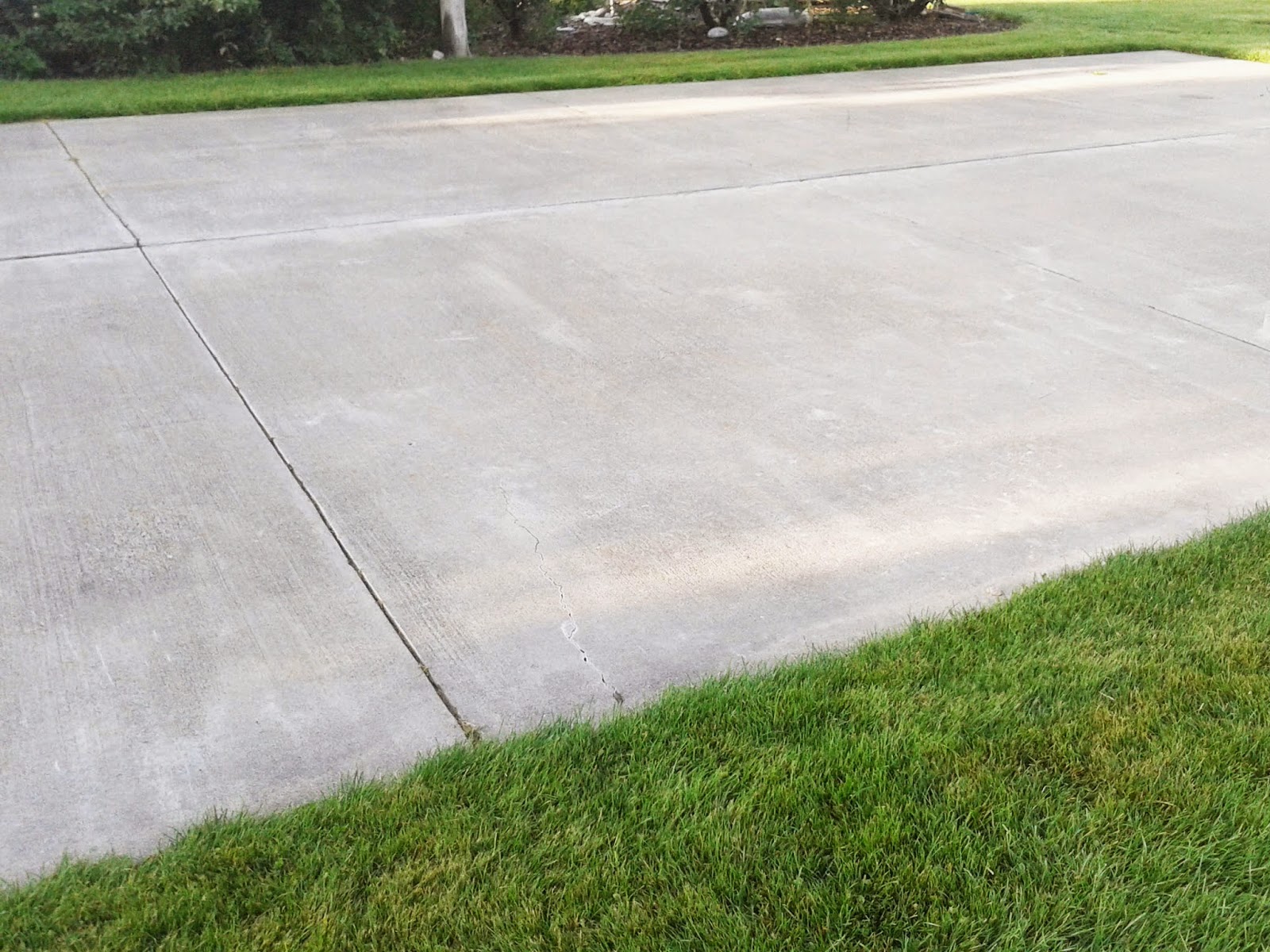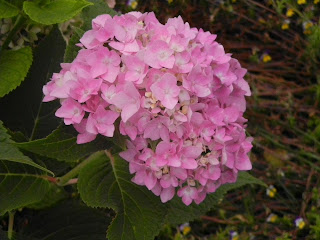Getting Ready for a Wedding--Acid Staining the Concrete
We have a concrete slab in our backyard that we call "the basketball court." It is where our children learned to ride bikes and where countless games of Horse have been played. For the wedding, it will serve as the dance floor.
When I looked at this utilitarian, but ugly, concrete and imagined the chiffon lined tent complete with chandeliers that will cover it for the wedding, the designer in me said, "No, no, no, this will not do at all!" The floor under the tent needed to be something more attractive. But concrete is what we had, and we weren't getting rid of it. So what was I to do?
I knew concrete can be stained, and thought, "How hard can it be to do?" That kind of thinking has sometimes served we well and sometimes gotten me into trouble. And to be honest, going into this I wasn't sure which way this project would turn out, even though I kept telling my husband, "Trust me."
The first thing I had to do was research concrete stain because I had never done this before and knew nothing about it except that it could be done. I learned that there are two kinds of concrete stain: acrylic and acid.
Acrylic stains are similar to paint in that they coat the surface of the concrete. Their advantages include being water based and coming in a wide range of colors. On the down side, because they coat the surface, they can peel or flake off like paint can.
Acid stains contain chemicals that react with the concrete and actually change its color. One advantage to this is the permanence of the color. And the end look, which is mottled and stone-like rather than a solid color, is very attractive. However, the selection of colors is more limited than with acrylic, and because each slab of concrete is different in its make-up, dealers who sell acid stain can't tell you exactly how your particular slab will look after it is stained. They can give you a basic idea of what each color usually comes out as, but no guarantees. Also, you are dealing with acid with this product.
With the harsh winters and wide temperature swings in this area, I figured anything that had the potential of peeling and flaking, probably would. So I decided to go with an acid stain.
The first step was to clean the concrete thoroughly. I purchased a concrete cleaner from the online site I purchased the acid stain from, and used it. Our concrete is old--over 20 years--but it seemed pretty clean, so we didn't spend a lot of time on this. However, it was amazing when we put the acid stain on how we could immediately see where residues from previous activities (like setting off fireworks and sealing crafts) were. These spots changed color differently than the rest of the slab. However, since the goal was to get the look of stone, and stone isn't all one solid color, I was okay with it.
Once the concrete was completely dry from cleaning, we applied the acid stain using a pump sprayer.
With acid stain, you can't tell what color the end product will be even after you apply it. Our stain, which was called saddle brown, looked yellow when we first applied it. The end color is dependent on several factors: the color you apply, the make-up of your concrete, how long you wait before neutralizing it, and whether you apply the stain full strength or dilute it.
Because I didn't want a very dark color, we diluted our stain at a ratio of 1:1 with distilled water. Then rather than waiting a full 24 hours, which is the maximum time you should wait, we neutralized our stain after about seven hours. Neutralizing is done by spraying ammonia water on the concrete.
The next step was to rinse the concrete. The chemical reaction that takes place during acid staining leaves a residue on the concrete, so it isn't until you rinse it off that you see what your final color is.
You can see the difference more easily in these before and after pictures I took close-up of the concrete.
The difference in my concrete slab is subtle compared to some of the images I saw when I googled concrete acid stain. By going darker and shinier, you can get some stunning results. However, I didn't want the basketball court to dominate our backyard, so I kept it lighter.
The basketball court is now ready to serve as the place to boogie the night away at the wedding. After that, it will still work well for a game of Horse.
When I looked at this utilitarian, but ugly, concrete and imagined the chiffon lined tent complete with chandeliers that will cover it for the wedding, the designer in me said, "No, no, no, this will not do at all!" The floor under the tent needed to be something more attractive. But concrete is what we had, and we weren't getting rid of it. So what was I to do?
I knew concrete can be stained, and thought, "How hard can it be to do?" That kind of thinking has sometimes served we well and sometimes gotten me into trouble. And to be honest, going into this I wasn't sure which way this project would turn out, even though I kept telling my husband, "Trust me."
The first thing I had to do was research concrete stain because I had never done this before and knew nothing about it except that it could be done. I learned that there are two kinds of concrete stain: acrylic and acid.
Acrylic stains are similar to paint in that they coat the surface of the concrete. Their advantages include being water based and coming in a wide range of colors. On the down side, because they coat the surface, they can peel or flake off like paint can.
Acid stains contain chemicals that react with the concrete and actually change its color. One advantage to this is the permanence of the color. And the end look, which is mottled and stone-like rather than a solid color, is very attractive. However, the selection of colors is more limited than with acrylic, and because each slab of concrete is different in its make-up, dealers who sell acid stain can't tell you exactly how your particular slab will look after it is stained. They can give you a basic idea of what each color usually comes out as, but no guarantees. Also, you are dealing with acid with this product.
With the harsh winters and wide temperature swings in this area, I figured anything that had the potential of peeling and flaking, probably would. So I decided to go with an acid stain.
The first step was to clean the concrete thoroughly. I purchased a concrete cleaner from the online site I purchased the acid stain from, and used it. Our concrete is old--over 20 years--but it seemed pretty clean, so we didn't spend a lot of time on this. However, it was amazing when we put the acid stain on how we could immediately see where residues from previous activities (like setting off fireworks and sealing crafts) were. These spots changed color differently than the rest of the slab. However, since the goal was to get the look of stone, and stone isn't all one solid color, I was okay with it.
Once the concrete was completely dry from cleaning, we applied the acid stain using a pump sprayer.
With acid stain, you can't tell what color the end product will be even after you apply it. Our stain, which was called saddle brown, looked yellow when we first applied it. The end color is dependent on several factors: the color you apply, the make-up of your concrete, how long you wait before neutralizing it, and whether you apply the stain full strength or dilute it.
Because I didn't want a very dark color, we diluted our stain at a ratio of 1:1 with distilled water. Then rather than waiting a full 24 hours, which is the maximum time you should wait, we neutralized our stain after about seven hours. Neutralizing is done by spraying ammonia water on the concrete.
The next step was to rinse the concrete. The chemical reaction that takes place during acid staining leaves a residue on the concrete, so it isn't until you rinse it off that you see what your final color is.
The last step is to apply a sealer. A high gloss sealer makes the concrete look the way it does when it is wet. A low gloss sealer gives it a bit of a sheen, but makes it less shiny and lighter. I went with the lower gloss.
Here is the final result.
You can see the difference more easily in these before and after pictures I took close-up of the concrete.
 |
| Before |
 |
| After |
The basketball court is now ready to serve as the place to boogie the night away at the wedding. After that, it will still work well for a game of Horse.







Comments
Post a Comment